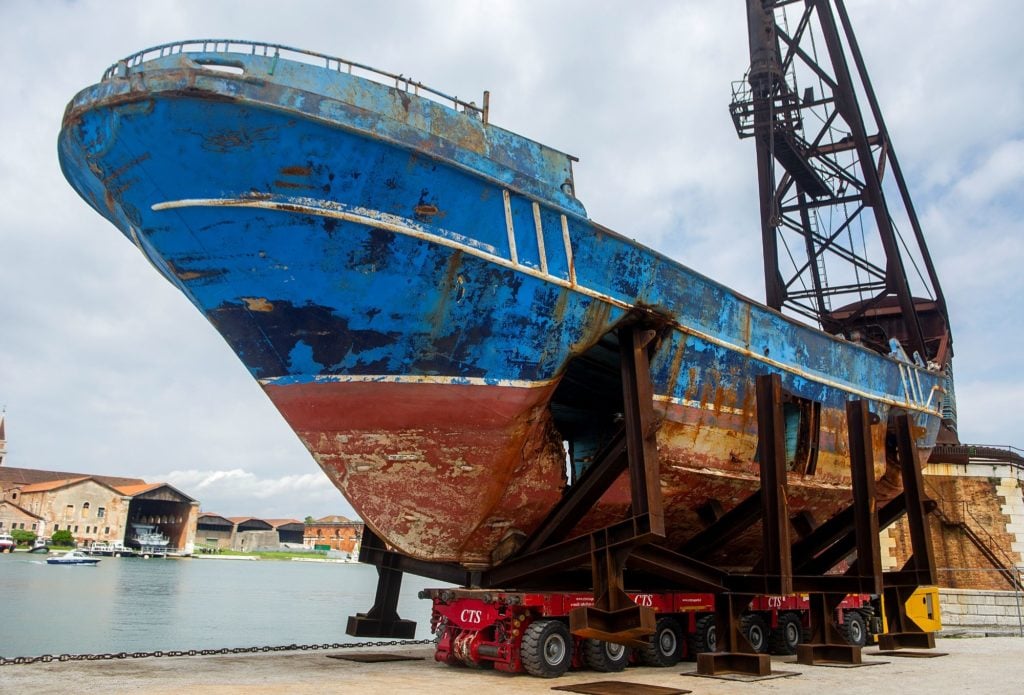Politics
‘Absolutely Vile’ or ‘Powerful’? Christoph Buchel’s Migrant Boat Is the Most Divisive Work at the Venice Biennale
The provocative artist is showing, as a work of art, a ship in which hundreds of migrants drowned in 2015.

The provocative artist is showing, as a work of art, a ship in which hundreds of migrants drowned in 2015.

Javier Pes &
Naomi Rea

At the Venice Biennale last week, artist Christoph Büchel unveiled his most provocative work thus far: Barca Nostra (Our Boat), the rusting hulk of a barge that sank in the Mediterranean in 2015 and took with it up to 1,100 migrants fleeing north Africa, whose bodies were later recovered from the seabed along with the ship.
Whether the work is a poignant memorial to the tragedy or a tasteless photo-opportunity in the context of the Venice Biennale, depends on your point of view. But one thing is certain: the backlash has been swift.
When Eva and Adele, the ever-present performance artists, posed for selfies in front of the ship, it summed up for many their doubts about Büchel’s contribution to the exhibition.
“Nauseous,” the curator Vincent Honoré responded in an Instagram post. The artist Candice Breitz, who represented South Africa at the 2017 Venice Biennale, called it “absolutely vile.”
Some are willing to give early viewers of the boat the benefit of the doubt: the ship is accompanied by no label or descriptive text to provide context about its history—a condition on which the artist insisted, and which the Biennale’s artistic director, Ralph Rugoff, has accepted, albeit perhaps reluctantly.
Speaking to the British television station Channel 4, Rugoff noted that historical context is provided in the exhibition’s catalogue, but that it should “also be freely available to visitors who don’t have the means or desire to purchase those publications. I think it should be possible to do this in a way that won’t compromise the artist’s intentions.” (The Biennale has this far not responded to arnet News’s request for comment, and the artist declined to be interviewed.)
The text in the catalogue explains that on April 18, 2015, the ship sank in the Mediterranean sea between Libya and the Italian island of Lampedusa. There were only 28 survivors. “Barca Nostra is dedicated to the victims and the people involved in its recovery,” the catalogue states.
“The work definitely triggers a strong reaction in me, as an Italian, as a collector, and as a president of a contemporary art institution,” the art collector Patrizia Sandretto Re Rebaudengo tells artnet News, referring to the fact that the ship has become a flash point in Italian debates about migration.
Exhibiting the boat could come across as a condemnation of the tragic events and dangerous conditions migrants face when fleeing war and poverty, she says. However, “there is a danger of spectacularization and manipulation.”
By Thursday afternoon, an online petition spearheaded by Siima Itabaaza to remove the work from the Biennale had been signed by 83 people. She says the lack of a label, and the boat’s position near a café, is “grossly disrespectful and insensitive.”
“The boat being displayed as an ‘artwork,’ without any explanatory text by a white male artist, continues the violence of white people appropriating Black bodies and Black death for public spectatorship and consumption,” she says.
The artist Tsedaye Makonnen was moved to stage an impromptu performance in response to the work during the Biennale’s opening week. In a work called When Drowning is the Best Option, Makonnen scattered white rose petals around the installation before lying down on the ground, clutching a skull in front of the controversial work.
According to Makonnen’s Instagram, she was hassled by Biennale representatives and the Italian police, who formed a blockade around the installation. “How ironic that the Biennale created a border around the boat (which they were specifically instructed by the artist #christophebuchel, who installed the boat, not to do), sounds a lot like the present reality,” Makonnen wrote.
Another artist, Augustas Serapinas, whose work was also included in main Venice Biennale exhibition, told artnet News that he has mixed feelings about the work. “How the work is mediated is a crucial aspect of it,” he says, noting that many VIPs, in their rush to see the show, blew right past the ship.
“In a way, those people make it even more powerful,” Serapinas says. “Because they are all taking selfies, eating, celebrating, and hanging out around it, and it’s just part of the background scenography of their Instagrams. They’re not even aware that this boat is next to them. And I think those people, who are not aware of that, are not aware of the [migrant] crisis in general.”
He remarked on how people’s reactions to the ship changed as information about it became more widely available. “I think it was really working well when it was the opening, and maybe it would be better to remove it afterwards,” he says. “Because now people know about it, it’s already well mediated in that sense, and it becomes a cheap trick in a way.”
Where the boat will end up after the Venice Biennale is unclear. One proposal, which predates Büchel’s intervention, is to have it travel like a “Trojan horse” throughout Europe as a symbol of the right to move freely across borders. Another would make the ship the centerpiece of a “Garden of Memory” in Sicily. And a third idea would be to transform the wreck into a human rights museum in Milan, which has gained the approval of the city government.
On the other side of the political divide, the anti-immigrant Italian politician Mattaeo Salvini, who is the deputy prime minister, denounced Barca Nostra as “propaganda.”